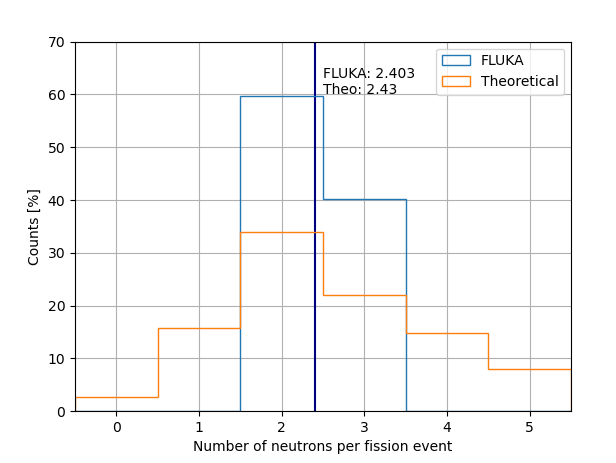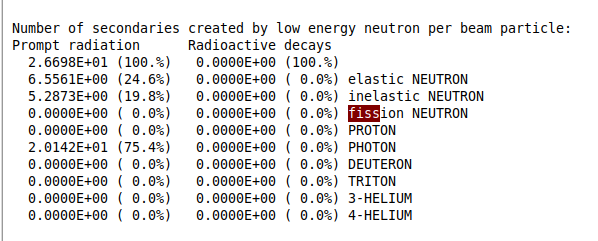Dear @riya,
First of all, let me apologize for the delayed answer. After looking carefully at this use case, it is unfortunately not possible to retrieve the number of neutrons per each fission event, but let me add more information.
a. Currently, there is no flag in FLUKA that identifies fission events to the user, but one can work around this by looking at the number of heavy products from an interaction. We know that for a fission event, there should always be NPHEAVY=2 products in a fission event, therefore one could indeed use an mgdraw.f (11.4 KB) routine for this, and you can see the results plotted here.

FLUKA outputs only 2 or 3 neutrons (respecting the ~2.43 mean for 235Ur), instead of a Poisson distribution with events also at 0, 1 or 4+ neutrons per fission.
Inside FLUKA there are several approaches for sampling the fission neutrons.
- The default is the binomial sampling between 2-3 such a way to reflect the database neutron multiplicity.
- There is Poissonian way of sampling with an average of \nu.
- Applying Bayesian Distortion to the fission yield distribution such as to the distribution of the fission fragments to reflect the library.
Since all distributions in the neutronic libraries are inclusive there is no easy way to reproduce all distributions when we are sampling the final states. For the fission reaction it was chosen the 1st approach, since it was the one that was minimizing the distortion of the other distributions. The Poisson sampling was altering the second fission fragment distribution, so we do not offer it to the user, hence the behaviour above.
b. Also, please note that there is a table printed in the output file mentioned above. In your reply, you were using the neutron group-wise treatment, as initially suggested. However, if you use the point-wise neutron treatment, then you get more sensible results, e.g. as:
Number of secondaries created by low energy neutron per beam particle:
Prompt radiation Radioactive decays
3.3584E+00 (100.%) 0.0000E+00 (100.%)
1.2870E-01 ( 3.8%) 0.0000E+00 ( 0.0%) elastic NEUTRON
3.3100E-02 ( 1.0%) 0.0000E+00 ( 0.0%) inelastic NEUTRON
2.0891E+00 (62.2%) 0.0000E+00 ( 0.0%) fission NEUTRON
0.0000E+00 ( 0.0%) 0.0000E+00 ( 0.0%) PROTON
1.1406E+00 (34.0%) 0.0000E+00 ( 0.0%) PHOTON
0.0000E+00 ( 0.0%) 0.0000E+00 ( 0.0%) DEUTERON
0.0000E+00 ( 0.0%) 0.0000E+00 ( 0.0%) TRITON
0.0000E+00 ( 0.0%) 0.0000E+00 ( 0.0%) 3-HELIUM
0.0000E+00 ( 0.0%) 0.0000E+00 ( 0.0%) 4-HELIUM
Unfortunately, these are not fully correct, since they are per BEAM particle, and not per FISSION event. One could have more fission events per beam (consider the case of a secondary neutron generating a fission event and so on in a chain reaction), or beam neutrons not interacting.
Please let me know if there is something else I could help with!
Thank you,
Daniel

